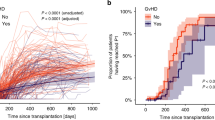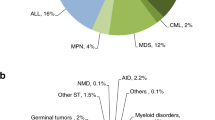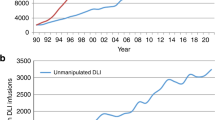Abstract
It is known that the number of transplanted cells has a significant impact on the outcome after SCT. We identify issues that cannot be addressed by conventional analysis of clinical trials and ask whether it is possible to develop a refined analysis to conclude about the outcome of individual patients given clinical trial results. To accomplish this, we propose an interdisciplinary approach based on mathematical modeling. We devise and calibrate a mathematical model of short-term reconstitution and simulate treatment of large patient groups with random interindividual variation. Relating model simulations to clinical data allows quantifying the effect of transplant size on reconstitution time in the terms of patient populations and individual patients. The model confirms the existence of lower bounds on cell dose necessary for secure and efficient reconstitution but suggests that for some patient subpopulations higher thresholds might be appropriate. Simulations demonstrate that relative time gain because of increased cell dose is an ‘interpersonally stable’ parameter, in other words that slowly engrafting patients profit more from transplant enlargements than average cases. We propose a simple mathematical formula to approximate the effect of changes of transplant size on reconstitution time.
This is a preview of subscription content, access via your institution
Access options
Subscribe to this journal
Receive 12 print issues and online access
$259.00 per year
only $21.58 per issue
Buy this article
- Purchase on Springer Link
- Instant access to full article PDF
Prices may be subject to local taxes which are calculated during checkout





Similar content being viewed by others
References
Deeg H, Sandmaier B . Who is fit for allogeneic transplantation? Blood 2010; 116: 4762–4770.
To LB, Levesque JP, Herbert KE . How I treat patients who mobilize hematopoietic stem cells poorly. Blood 2011; 118: 4530–4540.
Trébéden-Negre H, Rosenzwajg M, Tanguy ML, Lefrere F, Azar N, Heshmati F et al. Delayed recovery after autologous peripheral hematopoietic cell transplantation: potential effect of a high number of total nucleated cells in the graft. Transfusion 2010; 50: 2649–2659.
Kozlowska-Skrzypczak M, Gil L, Komarnicki M . Factors affecting neutrophil recovery after autologous bone marrow-derived stem cell transplantation in patients with acutemyeloid leukemia. Transplant Proc 2009; 41: 3868–3872.
Weaver CH, Hazelton B, Birch R, Palmer P, Allen C, Schwartzberg L et al. An analysis of engraftment kinetics as a function of the CD34 content of peripheral blood progenitor cell collections in 692 patients after the administration of myeloablative chemotherapy. Blood 1995; 86: 3961–3969.
Magauran CE, Salgado CD . Challenges and advances in infection control of hematopoietic stem cell transplant recipients. Infect Disord Drug Targets 2011; 11: 18–26.
Post MJ, Lass-Floerl C, Gastl G, Nachbaur D . Invasive fungal infections in allogeneic and autologous stem cell transplant recipients: a single-center study of 166 transplanted patients. Transpl Infect Dis 2007; 9: 189–195.
Liu F, Wu T, Wang JB, Cao XY, Yin YM, Zhao YL et al. Risk factors for recurrence of invasive fungal infection during secondary antifungal prophylaxis in allogeneic hematopoietic stem cell transplant recipients. Transpl Infect Dis 2013; 15: 243–250.
Puig N, De La Rubia J, Jarque I, Salavert M, Moscardó F, Sanz J et al. Characteristics of and risk factors for pneumonia in patients with hematological malignancies developing fever after autologous blood stem cell transplantation. Leuk Lymphoma 2007; 48: 2367–2374.
Safdar A, Rodriguez GH, De Lima MJ, Petropoulos D, Chemaly RF, Worth LL et al. Infections in 100 cord blood transplantations: spectrum of early and late posttransplant infections in adult and pediatric patients 1996–2005. Medicine 2007; 86: 324–333.
Rocha V, Broxmeyer HE . New approaches for improving engraftment after cord blood transplantation. Biol Blood Marrow Transplant 2010; 16: S126–S132.
Delaney M, Ballen KK . Umbilical cord blood transplantation: review of factors affecting the hospitalized patient. J Intensive Care Med 2013 (Epub ahead of print).
Ballen KK, Koreth J, Chen YB, Dey BR, Spitzer TR . Selection of optimal alternative graft source: mismatched unrelated donor, umbilical cord blood, or haploidentical transplant. Blood 2012; 119: 1972–1980.
Zubair A, Zahrieh D, Daley H, Schott D, Gribben JG, Freedman A et al. Early neutrophil engraftment following autologous BMT provides a functional predictor of long-term hematopoietic reconstitution. Transfusion 2003; 43: 614–621.
Avery S, Voss MH, Gonzales AM, Lubin M, Castro-Malaspina H, Giralt S et al. Importance of day 21 BM chimerism in sustained neutrophil engraftment following double-unit cord blood transplantation. Bone Marrow Transplant 2012; 47: 1056–1060.
Wang Y, Liu DH, Liu KY, Xu LP, Zhang XH, Han W et al. Long-term follow-up of haploidentical hematopoietic stem cell transplantation without in vitro T cell depletion for the treatment of leukemia: nine years of experience at a single center. Cancer 2013; 119: 978–985.
Ramírez P, Brunstein CG, Miller B, Defor T, Weisdorf D . Delayed platelet recovery after allogeneic transplantation: a predictor of increased treatment-related mortality and poorer survival. Bone Marrow Transplant 2011; 46: 981–986.
Kröger N, Zabelina T, Krüger W, Renges H, Stute N, Schrum J et al. Patient cytomegalovirus seropositivity with or without reactivation is the most important prognostic factor for survival and treatment-related mortality in stem cell transplantation from unrelated donors using pretransplant in vivo T-cell depletion with anti-thymocyte globulin. Br J Haematol 2001; 113: 1060–1071.
Klaus J, Herrmann D, Breitkreutz I, Hegenbart U, Mazitschek U, Egerer G et al. Effect of CD34 cell dose on hematopoietic reconstitution and outcome in 508 patients with multiple myeloma undergoing autologous peripheral blood stem cell transplantation. Eur J Haematol 2007; 78: 21–28.
Engel C, Scholz M, Loeffler M . A computational model of human granulopoiesis to simulate the hematotoxic effects of multicycle polychemotherapy. Blood 2004; 104: 2323–2331.
Scholz M, Engel C, Loeffler M . Modelling human granulopoiesis under poly-chemotherapy with G-CSF support. J Math Biol 2005; 50: 397–439.
Colijn C, Foley C, Mackey MC . G-CSF treatment of canine cyclical neutropenia: a comprehensive mathematical model. Exp Hematol 2007; 35: 898–907.
Foley C, Mackey MC . Dynamic hematological disease: a review. J Math Biol 2009; 58: 285–322.
Colijn C, Mackey MC . A mathematical model of hematopoiesis: II Cyclical neutropenia. J Theor Biol 2005; 237: 133–146.
Roeder I, Loeffler M . A novel dynamic model of hematopoietic stem cell organization based on the concept of within-tissue plasticity. Exp Hematol 2002; 30: 853–861.
Roeder I, Horn M, Glauche I, Hochhaus A, Mueller MC, Loeffler M . Dynamic modeling of imatinib-treated chronic myeloid leukemia: functional insights and clinical implications. Nat Med 2006; 12: 1181–1184.
Lowenthal RM, Fabères C, Marit G, Boiron JM, Cony-Makhoul P, Pigneux A et al. Factors influencing haemopoietic recovery following chemotherapy-mobilised autologous peripheral blood progenitor cell transplantation for haematological malignancies:a retrospective analysis of a 10-year single institution experience. Bone Marrow Transplant 1998; 22: 763–770.
Pavletic Z, Bishop M, Tarantolo S, Martin-Algarra S, Bierman P, Vose J et al. Hematopoietic recovery after allogeneic blood stem-cell transplantation compared with bone marrow transplantation in patients with hematologic malignancies. J Clin Oncol 1997; 15: 1608–1616.
Schmitz N, Bacigalupo A, Hasenclever D, Nagler A, Gluckman E, Clark P et al. Allogeneic bone marrow transplantation vs filgrastim-mobilised peripheral blood progenitor cell transplantation in patients with early leukaemia: first results of a randomized multicentre trial of the European Group for Blood and Marrow Transplantation. Bone Marrow Transplant 1998; 21: 995–1003.
Vigorito A, Azevedo W, Marques J, Azevedo A, Eid K, Aranha F et al. A randomised, prospective comparison of allogeneic bone marrow and peripheral blood progenitor cell transplantation in the treatment of haematological malignancies. Bone Marrow Transplant 1998; 22: 1145–1151.
Bensinger W, Clift R, Martin P, Appelbaum F, Demirer T, Gooley T et al. Allogeneic peripheral blood stem cell transplantation in patients with advanced hematologic malignancies: a retrospective comparison with marrow transplantation. Blood 1996; 88: 2794–2800.
Aversa F, Reisner Y, Martelli M . The haploidentical option for high-risk haematological malignancies. Blood Cells Mol Dis 2008; 40: 8–12.
Kato S, Yabe H, Yasui M, Kawa K, Yoshida T, Watanabe A et al. Allogeneic hematopoietic transplantation of CD34+ selected cells from an HLA haplo-identical related donor. A long-term follow-up of 135 patients and a comparison of stem cell source between the bone marrow and the peripheral blood. Bone Marrow Transplant 2000; 26: 1281–1290.
Rubinstein P, Carrier C, Scaradavou A, Kurtzberg J, Adamson J, Migliaccio A et al. Outcomes among 562 recipients of placental-blood transplants from unrelated donors. N Engl J Med 1998; 339: 1565–1577.
Chunduri S, Dobogai L, Peace D, Saunthararajah Y, Chen H, Mahmud N et al. Comparable kinetics of myeloablation between fludarabine/full-dose busulfan and fludarabine/ melphalan conditioning regimens in allogeneic peripheral blood stem cell transplantation. Bone Marrow Transplant 2006; 38: 477–482.
Marciniak-Czochra A, Stiehl T, Jäger W, Ho AD, Wagner W . Modeling of asymmetric cell division in hematopoietic stem cells—regulation of self-renewal is essential for efficient repopulation. Stem Cells Dev 2009; 18: 377–385.
Marciniak-Czochra A, Stiehl T, Wagner W . Modeling of replicative senescence in hematopoietic development. Aging 2009; 1: 723–732.
Stiehl T, Marciniak-Czochra A . Characterization of stem cells using mathematicalmodels of multistage cell lineages. Math Comput Model 2011; 53: 1505–1517.
Thornley I, Sutherland DR, Nayar R, Sung L, Freedman MH, Messner HA . Replicative stress after allogeneic bone marrow transplantation: changes in cycling of CD34+CD90+ and CD34+CD90- hematopoietic progenitors. Blood 2001; 97: 1876–1878.
Jandl JH . Blood cell formation. In Jandl JH (eds). Textbook of Hematology. Little, Brown and Company: Boston, MA, USA, 1996 pp 1–69.
Lord B . Myeloid cell kinetics in response to hematopoietic growth factors. Baillieres Clin Haematol 1992; 5: 533–550.
Roelofs H, de Pauw ES, Zwinderman AH, Opdam SM, Willemze R, Tanke HJ et al. Homeostasis of telomere length rather than telomere shortening after allogeneic peripheral blood stem cell transplantation. Blood 2003; 101: 358–362.
To LB, Dyson PG, Juttner C . Cell-dose effect in circulating stem-cell autografting. Lancet 1986; 2: 404–405.
Chevallier P, Hebia-Fellah I, Planche L, Guillaume T, Bressolette-Bodin C, Coste-Burel M et al. Human herpes virus 6 infection is a hallmark of cord blood transplant in adults and may participate to delayed engraftment: a comparison with matched unrelated donors as stem cell source. Bone Marrow Transplant 2010; 45: 1204–1211.
Shaw BE, Maldonado H, Madrigal JA, Smith C, Petronzelli F, Mayor NP et al. Polymorphisms in the TNFA gene promoter region show evidence of strong linkage disequilibrium with HLA and are associated with delayed neutrophil engraftment in unrelated donor hematopoietic stem cell transplantation. Tissue Antigens 2004; 63: 401–411.
Akpek G, Pasquini MC, Logan B, Agovi MA, Lazarus HM, Marks DI et al. Effects of spleen status on early outcomes after hematopoietic cell transplantation. Bone Marrow Transplant 2013; 48: 825–831.
Helenglass G, Treleaven J, Parikh P, Aboud H, Smith C, Powles R . Delayed engraftment associated with splenomegaly in patients undergoing bone marrow transplantation for chronic myeloid leukaemia. Bone Marrow Transplant 1990; 5: 247–251.
Klumpp TR, Herman JH, Schnell MK, Goldberg SL, Mangan KF . Association between antibodies reactive with neutrophils, rate of neutrophil engraftment, and incidence of post-engraftment neutropenia following BMT. Bone Marrow Transplant 1996; 18: 559–564.
Matsuno N, Wake A, Uchida N, Ishiwata K, Araoka H, Takagi S et al. Impact of HLA disparity in the graft-versus-host direction on engraftment in adult patients receiving reduced-intensity cord blood transplantation. Blood 2009; 114: 1689–1695.
Gluckman E, Rocha V, Arcese W, Michel G, Sanz G, Chan KW et al. Factors associated with outcomes of unrelated cord blood transplant: guidelines for donor choice. Exp Hematol 2004; 32: 397–407.
Rocha V, Gluckman E, Eurocord-Netcord registry and European Blood and Marrow Transplant group. Improving outcomes of cord blood transplantation: HLA matching, cell dose and other graft- and transplantation-related factors. Br J Haematol 2009; 147: 262–274.
Cutler C, Kim HT, Sun L, Sese D, Glotzbecker B, Armand P et al. Donor-specific anti-HLA antibodies predict outcome in double umbilical cord blood transplantation. Blood 2011; 118: 6691–6697.
Malik S, Bolwell B, Rybicki L, Copelan O, Duong H, Dean R et al. Apheresis days required for harvesting CD34+ cells predicts hematopoietic recovery and survival following autologous transplantation. Bone Marrow Transplant 2011; 46: 1519–1525.
Acknowledgements
This work was part of the Collaborative Research Center, SFB 873 ‘Maintenance and Differentiation of Stem Cells in Development and Disease’. AM-C was supported by ERC Starting Grant ‘Biostruct’ and DFG Emmy-Noether-Programme. The authors would like to thank Professor Marek Kimmel for many helpful advice during preparation of the manuscript.
Author information
Authors and Affiliations
Corresponding author
Ethics declarations
Competing interests
The authors declare no conflict of intrest.
Additional information
Supplementary Information accompanies this paper on Bone Marrow Transplantation website
Supplementary information
Rights and permissions
About this article
Cite this article
Stiehl, T., Ho, A. & Marciniak-Czochra, A. The impact of CD34+ cell dose on engraftment after SCTs: personalized estimates based on mathematical modeling. Bone Marrow Transplant 49, 30–37 (2014). https://doi.org/10.1038/bmt.2013.138
Received:
Revised:
Accepted:
Published:
Issue Date:
DOI: https://doi.org/10.1038/bmt.2013.138
Keywords
This article is cited by
-
Understanding Hematopoietic Stem Cell Dynamics—Insights from Mathematical Modelling
Current Stem Cell Reports (2023)
-
Stability of the equilibria of a dynamic system modeling stem cell transplantation
Ricerche di Matematica (2020)
-
Oscillations in a white blood cell production model with multiple differentiation stages
Journal of Mathematical Biology (2020)
-
A structured population model of clonal selection in acute leukemias with multiple maturation stages
Journal of Mathematical Biology (2019)
-
How to Characterize Stem Cells? Contributions from Mathematical Modeling
Current Stem Cell Reports (2019)



